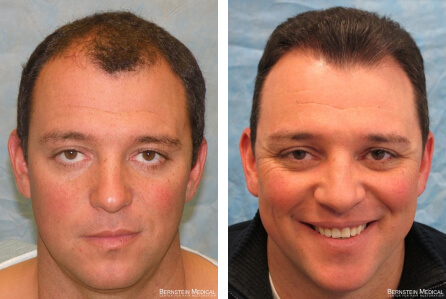Q: I had a hair restoration procedure and the hair grew, but after one year the hair was kinky and dry. It has remained like this ever since.
From what I have read Dr Bernstein says this is uncommon but can happen. I understand there is no definitive explanation for this but I would like Dr Bernstein’s opinion on why this happens. My theory is that DHT is more prominent on the top of the head and is changing the structure of the transplanted hair. The hair is so dry and unmanageable it looks like I am wearing a wig. I await his response. — P.O., Greenwich, CT
A: Some dryness and texture changes can occur after a hair transplant and this usually self-corrects over 1-2 years during which time the transplanted hair gradually regains its original luster and texture. These changes are most likely due to the unavoidable trauma that takes place as follicles are removed from the scalp and placed into recipient sites. Excessive dryness can occur if the sebaceous glands had been stripped away from the graft. In FUT, this can be due to over dissection (i.e., grafts that are trimmed too much). In FUE, this can be due to loss or damage to the sebaceous glands in the extraction process. Persistent kinkiness may represent either damage to grafts from the procedure (improper handling, crush injury) or effects of scarring in the recipient area (usually from older procedures which used larger recipient sites) that distort the growth of follicles.
- Read about post-op care following an FUT hair transplant
- Read about post-op care following a Robotic FUE hair transplant
- Read more Q&A about post-op care







